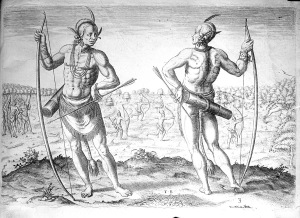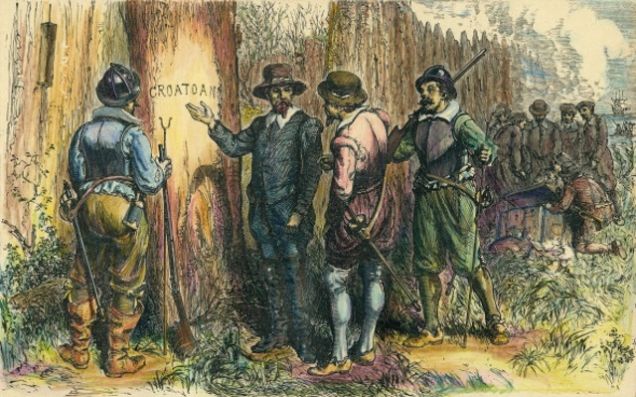The 16th century was drawing to a close when Queen Elizabeth set out to establish a permanent English settlement in the New World. The charter went to Walter Raleigh, who sent explorers Philip Amadas and Arthur Barlowe to scout out locations for a settlement.
The pair landed on Roanoke Island on July 4, 1584, establishing friendly relations with local natives, the Secotans and Croatans. They returned a year later with glowing reports of what we now call the Outer Banks of North Carolina. Two Native Croatans, Manteo and Wanchese, accompanied the pair back to England. All of London was abuzz with the wonders of the New World.

Queen Elizabeth was so pleased she knighted Raleigh. The new land was called “Virginia” in honor of the Virgin Queen.
Raleigh sent a party of 100 soldiers, miners and scientists to Roanoke Island, under the leadership of Captain Ralph Lane. The attempt was doomed from the start. They arrived too late in the season for planting, and Lane alienated the neighboring tribe when misunderstanding led to the murder of their chief, Wingina. By 1586 the new arrivals had had enough, and left the island.
Ironically, their supply ship arrived about a week later. Finding the island deserted, the vessel left 15 men behind to “hold the fort” before they too, departed.
The now knighted “Sir” Walter Raleigh was not to be deterred. He recruited 90 men, 17 women and 9 children for a more permanent “Cittie of Raleigh”, appointing John White governor. Among the colonists were White’s pregnant daughter, Eleanor, her husband Ananias Dare, and the Croatans Wanchese and Manteo.

The caravan stopped at Roanoke Island in July, 1587, to check on the 15 men left behind a year earlier. Raleigh believed that the Chesapeake afforded better opportunities for his new settlement, but his Portuguese pilot Simon Fernandes had other ideas.
Fernandes was a Privateer, impatient to resume his hunt for Spanish shipping. He ordered the colonists ashore on Roanoke Island. It could not have lifted the spirits of the small group to learn that the 15 left by the earlier expedition, had disappeared.
Eleanor Dare gave birth to a daughter on August 18, 1587, and called her Virginia. She was the first English child born to the new world.
Fernandez departed for England ten days later, taking along an anxious John White, who wanted to return to England for supplies. It was the last time Governor White would see his family.
 White found himself trapped in England by the invasion of the Spanish Armada, and the Anglo-Spanish war. It would be three years before he could return to Roanoke. He arrived on August 18, 1590, three years to the day from the birth of his granddaughter. White found the place deserted, save for the word “CROATOAN”, carved into a fence post. The letters “CRO” appeared on a nearby tree.
White found himself trapped in England by the invasion of the Spanish Armada, and the Anglo-Spanish war. It would be three years before he could return to Roanoke. He arrived on August 18, 1590, three years to the day from the birth of his granddaughter. White found the place deserted, save for the word “CROATOAN”, carved into a fence post. The letters “CRO” appeared on a nearby tree.

White had hopes of finding his family at Croatoan, the home of Chief Manteo’s people to the south, on modern day Hatteras Island.
A hurricane came up before he could explore further, his ships so damaged that he had return to England. Despite several attempts he never raised the resources to return.
What happened to the lost colonists of Roanoke, remains a mystery. They may have died of disease or starvation, or they may have been killed by hostile natives.
Perhaps they went to live with Chief Manteo’s people, after all. One of the wilder legends has Virginia Dare, now a young woman, transformed into a snow white doe by the evil medicine man Chico, but that must be a story for another day. The fate of the first English child born on American soil may never be known.

Seventeen years later another group of colonists would apply the lessons learned in Roanoke, founding their own colony a few miles up the coast at a place called Jamestown.
One personal anecdote involves a conversation I had with a woman in High Point, North Carolina, a few years back. She described herself as having Croatan ancestry, her family going back many generations on the outer banks. She described her Great Grandmother, a full blooded Croatan. The woman looked like it, too, except for those crystal blue eyes. She used to smile at the idea of the lost colony of Roanoke. “They’re not lost”, she would say. “They are us”.



One thought on “August 18, 1587 Lost Colony of Roanoke”